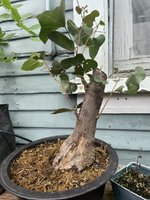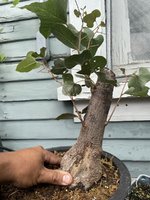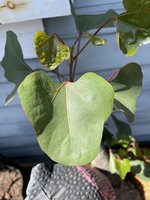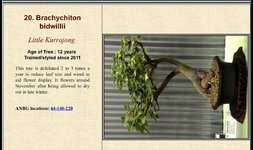Hello, I found this tree in pretty bad shape mid winter. It was about 6’ tall and someone had broken the trunk and what leaves it had were dead. I dug it up chopped the top once and again when it showed signs of growth. I have no idea what it is but you might?
You are using an out of date browser. It may not display this or other websites correctly.
You should upgrade or use an alternative browser.
You should upgrade or use an alternative browser.
Help identifying this tree please
- Thread starter EdyRay
- Start date
Mikecheck123
Omono
I'm assuming that you're in California, and if so, I believe this is a bottletree (Brachychiton populneus).
sorce
Nonsense Rascal
Welcome to Crazy!
Sorce
Sorce
Shibui
Imperial Masterpiece
Location can often give great clues to species ID so either tell us where the tree came from or fil your location in the personal profile for much better feedback.
Good ID @Mikecheck123 I agree that this looks very much like a Brachychiton species.
Down here these are natives but I don't know of anyone who would refer to B. populneus as bottle tree. The usual name for that species is Kurrajong as there are a couple of other more northern (tropical) species that have fatter trunks that are called bottle trees.
Brachychiton are relatively easy to transplant and respond well to pruning as you've already discovered but ramification of branching is difficult so it is unlikely you'll be able to build really dense branching.
FYI most growers down here would repot Brachychiton in warmer weather - late spring through to mid summer as they seem to respond better then.
Good ID @Mikecheck123 I agree that this looks very much like a Brachychiton species.
Down here these are natives but I don't know of anyone who would refer to B. populneus as bottle tree. The usual name for that species is Kurrajong as there are a couple of other more northern (tropical) species that have fatter trunks that are called bottle trees.
Brachychiton are relatively easy to transplant and respond well to pruning as you've already discovered but ramification of branching is difficult so it is unlikely you'll be able to build really dense branching.
FYI most growers down here would repot Brachychiton in warmer weather - late spring through to mid summer as they seem to respond better then.
Thank you @Mikecheck123 and @Shibui. I kept coming up with the Brachychiton species but the thin bottle tree foliage didn’t quite match and threw me off. Kurrajon is the specific name, I was able to find an img. of one as a bonsai. I look forward to adding this to my collection as I’ve never seen them as bonsai here in California. Is there a soil mix you recommend? @Shibui
Attachments
Mikecheck123
Omono
Good luck! There are so many Australian natives that I wanted to try. But that's much harder now that I've moved to the cold confines of zone 7. 
I still have one plucky Bailey acacia, which is actually hardy down to 20F. I keep dreaming of a bonsai with that surreal blue feathered foliage.
What's funny is that if you search for "bailey acacia bonsai", one of the top hits is actually my own bonsainut post where I'd listed a few for sale when I moved away from California. Not a great sign!
The other one, which I don't have, is the stately Geijera parviflora. But sadly, online scammers have completely obliterated it's name beyond all recognition such that 'Australian willow' now refers almost exclusively to online scammer sites selling garbage Salix cuttings.
I still have one plucky Bailey acacia, which is actually hardy down to 20F. I keep dreaming of a bonsai with that surreal blue feathered foliage.
What's funny is that if you search for "bailey acacia bonsai", one of the top hits is actually my own bonsainut post where I'd listed a few for sale when I moved away from California. Not a great sign!
The other one, which I don't have, is the stately Geijera parviflora. But sadly, online scammers have completely obliterated it's name beyond all recognition such that 'Australian willow' now refers almost exclusively to online scammer sites selling garbage Salix cuttings.
Shibui
Imperial Masterpiece
I've had a couple growing in my standard bonsai soil - 70% fine pine bark, 30% propagating sand for a few years but without spectacular success. I just checked the Victorian native bonsai club database but nobody has listed details for Kurrajong yet.Is there a soil mix you recommend?
The usual habitat for kurrajong, and most other Brachychiton sp, is open, well drained soils, deep sandy loams in drier areas or rocky hillsides down here in wetter areas so it would appear they don't like wet roots.
Good luck with this species.
Shibui
Imperial Masterpiece
Kurrajong can have a variety of leaf shapes too. Young trees often have deeply divided leaves that look way different to the normal heart shaped adult leaves.I kept coming up with the Brachychiton species but the thin bottle tree foliage didn’t quite match and threw me off.
Srt8madness
Omono
Good luck! There are so many Australian natives that I wanted to try. But that's much harder now that I've moved to the cold confines of zone 7.
I still have one plucky Bailey acacia, which is actually hardy down to 20F. I keep dreaming of a bonsai with that surreal blue feathered foliage.
What's funny is that if you search for "bailey acacia bonsai", one of the top hits is actually my own bonsainut post where I'd listed a few for sale when I moved away from California. Not a great sign!
The other one, which I don't have, is the stately Geijera parviflora. But sadly, online scammers have completely obliterated it's name beyond all recognition such that 'Australian willow' now refers almost exclusively to online scammer sites selling garbage Salix cuttings.
A bit late and a bit off topic, but what in particular makes the cuttings garbage? I've never bought them but took some cutting myself recently. Is it just garbage because they present them like they'll naturally grow into the bonsai pictured? Or because there is a better way than cuttings to propagate willows for bonsai?
Mikecheck123
Omono
Weeping willow is the worst possible bonsai species, perhaps.A bit late and a bit off topic, but what in particular makes the cuttings garbage? I've never bought them but took some cutting myself recently. Is it just garbage because they present them like they'll naturally grow into the bonsai pictured? Or because there is a better way than cuttings to propagate willows for bonsai?
Srt8madness
Omono
Soooo, based on nothing then, LOL.
Mikecheck123
Omono
Huh? I have years of experience eth just about every willow species you can buy.Soooo, based on nothing then, LOL.
Weeping willow is the worst.
Similar threads
- Replies
- 5
- Views
- 433
- Replies
- 1
- Views
- 473
- Replies
- 3
- Views
- 587




